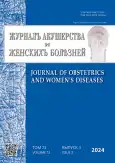Азбука будущего: продленное культивирование эмбрионов человека in vitro в питательной среде с эндометрием
- Авторы: Беспалова О.Н.1, Комарова Е.М.1, Лесик Е.А.1, Объедкова К.В.2, Тапильская Н.И.2, Коган И.Ю.1
-
Учреждения:
- Научно-исследовательский институт акушерства, гинекологии и репродуктологии им. Д.О. Отта
- Научно-исследовательский институт акушерства, гинекологии и репродуктологии им. Д. О. Отта
- Выпуск: Том 73, № 3 (2024)
- Страницы: 19-25
- Раздел: Оригинальные исследования
- URL: https://journals.rcsi.science/jowd/article/view/261037
- DOI: https://doi.org/10.17816/JOWD629131
- ID: 261037
Цитировать
Аннотация
Обоснование. Разработка новых систем культивирования эмбрионов модельных объектов, а также создание эмбриональных моделей на основе стволовых клеток позволяют более детально описать события раннего эмбриогенеза. Однако данные модели содержат ряд ограничений, позволяя лишь косвенно экстраполировать полученные знания на события, происходящие in vivo. Несмотря на определенные ограничения, в том числе, связанные с некоторыми отличиями эмбрионов, развивающимися in vivo и in vitro, условиями имплантации in vivo и in vitro и сроком культивирования эмбрионов человека, у данного направления есть большие перспективы для дальнейшего развития.
Цель исследования — оценить жизнеспособность и потенциал к развитию эмбрионов человека со стадии бластоцисты при их длительном сокультивировании с эндометрием в питательной среде, предназначенной для культивирования до стадии бластоцисты.
Материалы и методы. Эмбрионы, полученные посредством вспомогательных репродуктивных технологий, культивировали со стадии бластоцисты до 19-го дня развития в питательной среде, предназначенной для культивирования до стадии бластоцисты, в присутствии эндометрия. На 19-й день развития эмбрионы и фрагменты эндометрия оценивали под инвертированным микроскопом с использованием модуляционного контраста Хоффмана.
Результаты. При визуальной оценке под инвертированным микроскопом на 19-й день развития и 13–14-й день сокультивирования с эндометрием в питательной среде зафиксированы жизнеспособные развивающиеся эмбрионы без признаков деградации, как свободно располагающиеся в массе недифференцированных клеток, так и находящиеся в непосредственном контакте с эндометрием.
Заключение. Полученные данные свидетельствуют о способности эмбриона к дальнейшему развитию со стадии бластоцисты до 19-го дня в питательной среде, предназначенной для культивирования до стадии бластоцисты, в присутствии эндометрия. Это может служить экспериментальной моделью как для оценки рецептивности эндометрия in vitro, так и для изучения межклеточных взаимодействий в процессе имплантации.
Ключевые слова
Полный текст
Открыть статью на сайте журналаОб авторах
Олеся Николаевна Беспалова
Научно-исследовательский институт акушерства, гинекологии и репродуктологии им. Д.О. Отта
Email: shiggerra@mail.ru
ORCID iD: 0000-0002-6542-5953
SPIN-код: 4732-8089
д-р мед. наук
Россия, Санкт-ПетербургЕвгения Михайловна Комарова
Научно-исследовательский институт акушерства, гинекологии и репродуктологии им. Д.О. Отта
Автор, ответственный за переписку.
Email: evgmkomarova@gmail.com
ORCID iD: 0000-0002-9988-9879
SPIN-код: 1056-7821
канд. биол. наук
Россия, Санкт-ПетербургЕлена Александровна Лесик
Научно-исследовательский институт акушерства, гинекологии и репродуктологии им. Д.О. Отта
Email: lesike@yandex.ru
ORCID iD: 0000-0003-1611-6318
SPIN-код: 6102-4690
канд. биол. наук
Россия, Санкт-ПетербургКсения Владимировна Объедкова
Научно-исследовательский институт акушерства, гинекологии и репродуктологии им. Д. О. Отта
Email: obedkova_ks@mail.ru
ORCID iD: 0000-0002-2056-7907
SPIN-код: 2709-2890
канд. мед. наук
Россия, Санкт-ПетербургНаталья Игоревна Тапильская
Научно-исследовательский институт акушерства, гинекологии и репродуктологии им. Д. О. Отта
Email: tapnatalia@yandex.ru
ORCID iD: 0000-0001-5309-0087
SPIN-код: 3605-0413
док. мед. наук, профессор
Россия, Санкт-ПетербургИгорь Юрьевич Коган
Научно-исследовательский институт акушерства, гинекологии и репродуктологии им. Д.О. Отта
Email: ikogan@mail.ru
ORCID iD: 0000-0002-7351-6900
SPIN-код: 6572-6450
д-р мед. наук, профессор, чл.-корр. РАН
Россия, Санкт-ПетербургСписок литературы
- ISSCR. Guidelines for the conduct of human embryonic stem cell research. Version 1: December 21, 2006. [Internet]. Дата обращения: 12.02.2024. Режим доступа: https://www.forth.gr/_gfx/pdf/ISSCRhESCguidelines2006.pdf
- ISSCR. Guidelines for Stem Cell Research and Clinical Translation update. Version 1.0, May 2021. [Internet]. Дата обращения: 12.02.2024. Режим доступа: https://research.wisc.edu/wp-content/uploads/sites/2/2021/10/isscr-guidelines-for-stem-cell-research-and-clinical-translation-2021.pdf
- Беспалова О.Н., Коган И.Ю., Комарова Е.М. и др. Опыт продленного культивирования эмбрионов человека in vitro в питательной среде с эндометрием. Пилотное исследование // Журнал акушерства и женских болезней. 2022. Т. 71, № 4. C. 13–20. EDN: ZMYAAQ doi: 10.17816/JOWD109215
- Gardner D., Schoolcraft W. In-vitro culture of human blastocyst. In: Towards reproductive certainty: fertility and genetics beyond / ed. by Jansen R., Mortimer D. Carnforth: Parthenon Publ., 1999. P. 378–388.
- Zhai J., Xiao Z., Wang Y., et al. Human embryonic development: from peri-implantation to gastrulation // Trends Cell Biol. 2022. Vol. 32, N. 1. P. 18–29. doi: 10.1016/j.tcb.2021.07.008
- Koot Y.E., Teklenburg G., Salker M.S., et al. Molecular aspects of implantation failure // Biochim Biophys Acta. 2012. Vol. 1822, N. 12. P. 1943–1950. doi: 10.1016/j.bbadis.2012.05.017
- Sharkey A.M., Macklon N.S. The science of implantation emerges blinking into the light // Reprod Biomed Online. 2013. Vol. 27, N. 5. P. 453–460. doi: 10.1016/j.rbmo.2013.08.005
- Weimar C.H., Post Uiterweer E.D., Teklenburg G., et al. In-vitro model systems for the study of human embryo-endometrium interactions // Reprod Biomed Online. 2013. Vol. 27, N. 5. P. 461–476. doi: 10.1016/j.rbmo.2013.08.002
Дополнительные файлы









